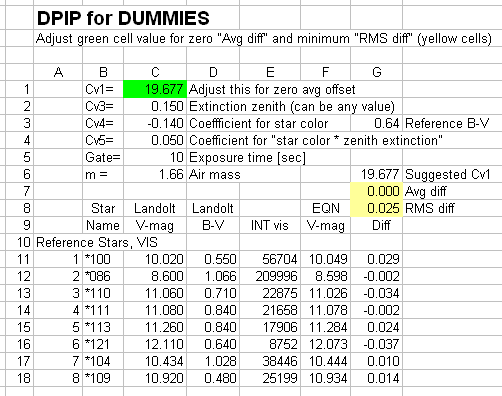
This web page illustrates the appearance of a spreadsheet that I use
to determine a "photometry zero shift constant" that allows me to
convert star intensity measurements to magnitude.
Before using a spreadsheet like this the user must observe a Landolt
star field. For the case illustrated here, only one such star field was
observed, and it was observed at only one air mass value. The median
combined image of several exposures of this star field is used to
measure "intensity" for each Landolt star. These values are entered in
cells E11..E18 of the following spreadsheet.

Figure 1. Example of an Excel spreadsheet for determining
the telescope system's zero shift constant (green, cell C1). As the
value of cell C1 is manually changed the average difference value in
cell G7 changes. Additional description of this spreadsheet is in the
text.
The Landolt knwon magnitudes and B-V values are entered into the
spreadsheet in cells C11..D18. An equation for converting intensity to
magnitude displays magnitude values in cells F11..F18. The equation has
the form:
Mag = 19.677 - LOG ( INTv / g ) - 0.15 * m - 0.14
* (B-V -0.64) + 0.05 * m * (B-V -0.64)
where INTv = measured
intensity using V-filter, g = exposure time, m = air mass, B-V = star
color
Differences between the equation magnitude and Landolt magnitude are
displayed in cells G11..G18, and their average value adn RMS difference
are displayed in the yellow cells G7 and G8. The value in green cell C1
is adjusted until the average difference (cell G8) is zero.
Other spreadsheets can be used to establish the photometry zero
shift constant for the other filters.
Return to Photometry Method #3
____________________________________________________________________
This site opened: January 4, 2005. Last Update: January 4, 2005